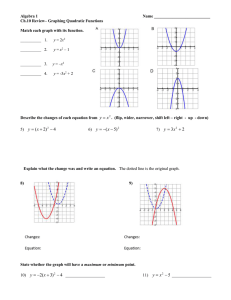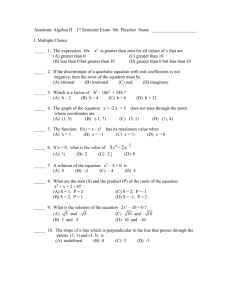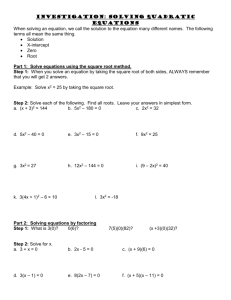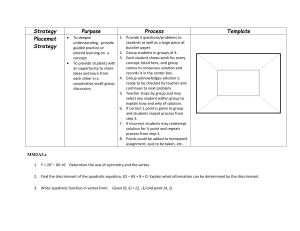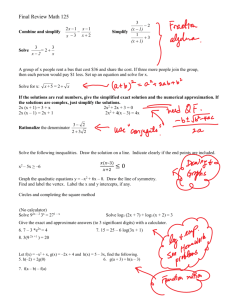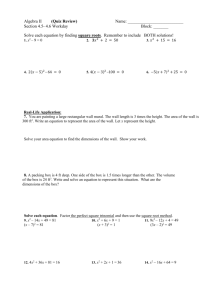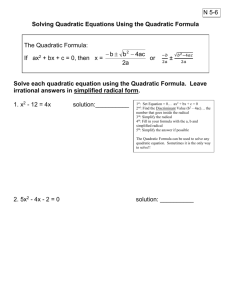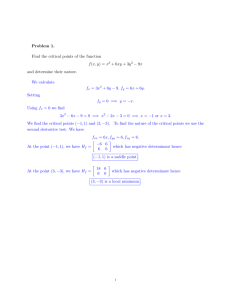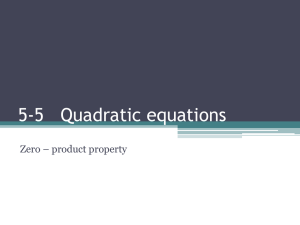Unit 2 Review Sheet
advertisement
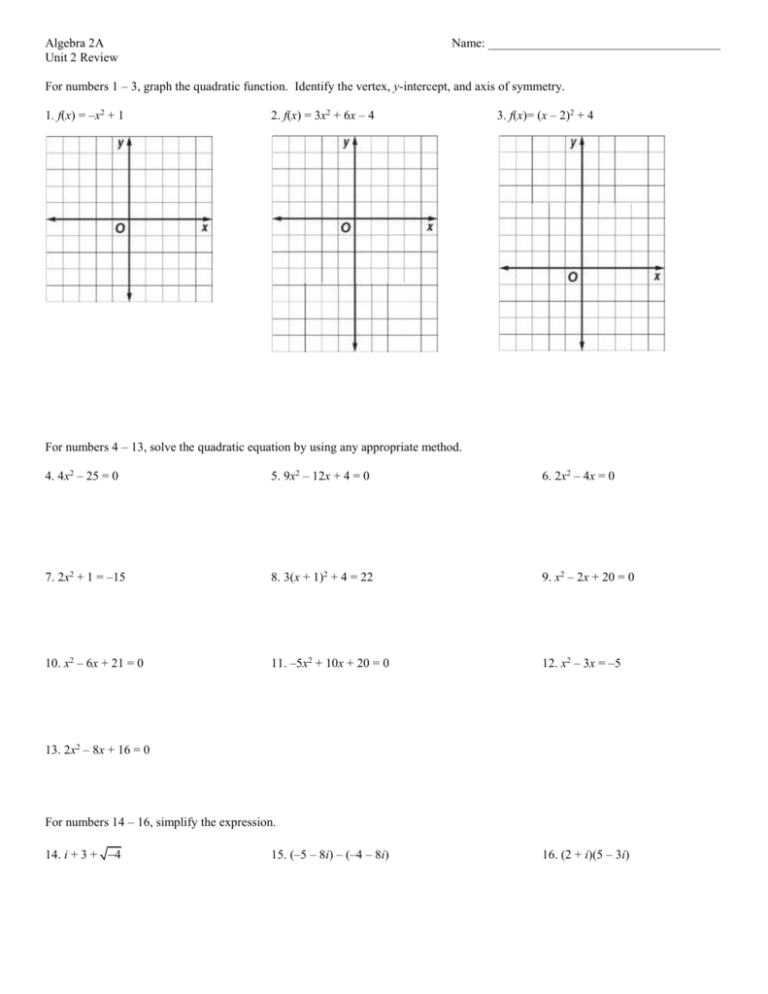
Algebra 2A Unit 2 Review Name: _____________________________________ For numbers 1 – 3, graph the quadratic function. Identify the vertex, y-intercept, and axis of symmetry. 1. f(x) = –x2 + 1 2. f(x) = 3x2 + 6x – 4 3. f(x)= (x – 2)2 + 4 For numbers 4 – 13, solve the quadratic equation by using any appropriate method. 4. 4x2 – 25 = 0 5. 9x2 – 12x + 4 = 0 6. 2x2 – 4x = 0 7. 2x2 + 1 = –15 8. 3(x + 1)2 + 4 = 22 9. x2 – 2x + 20 = 0 10. x2 – 6x + 21 = 0 11. –5x2 + 10x + 20 = 0 12. x2 – 3x = –5 13. 2x2 – 8x + 16 = 0 For numbers 14 – 16, simplify the expression. 14. i + 3 + 4 15. (–5 – 8i) – (–4 – 8i) 16. (2 + i)(5 – 3i) For numbers 17 & 18, find the discriminant and give the number and type of solutions of the equation. 17. 6x2 = 4 – 5x 18. 2x2 – 3x = –4 For numbers 19 & 20, graph the quadratic inequality. 19. y ≤ 2x2 – 1 20. y > x2 – 6x + 6 21. Write the following equation in vertex form. Then identify the vertex, axis of symmetry, domain, and range: y = x2 + 16x – 21 22. The height h (in feet) of a certain aircraft t seconds after it leaves the ground is modeled by h(t) = –16t2 + 64t + 12. When will the aircraft reach its maximum height? What will the maximum height be? 23. Ana throws a rock into the air with an initial velocity of 27 feet per second. Her hand is 6 feet above the ground when she throws the rock. h = –16t2 + vo t + ho h = ending height (feet) t = time (seconds) vo = initial velocity (feet per second) ho = initial height (feet) a) Write a vertical motion model for the height of the rock after it is thrown. b) Use the model to determine how long the rock remains in the air. 24. Solve 2x2 + 5x – 7 ≤ 0 For numbers 25 – 28, identify in which step, if any, that an error occurred. 25. Find the discriminant of: 3x2 – 5x = 7. Step 1: a = 3, b = –5, c = 7 Step 2: discriminant = b2 – 4ac = (–5)2 – 4(3)(7) Step 3: discriminant = –59 26. Solve: 2x2 – 9x = –4 Step 1: 2x2 – 9x + 4 = 0 Step 2: x2 – 9x + 8 = 0 Step 3: (x – 8)(x – 1) = 0 8 1 Step 4: x x 0 2 2 Step 5: (x – 4)(2x – 1) = 0 Step 6: x – 4 = 0 OR 2x – 1 = 0 1 Step 7: x = 4 OR x 2 27. Solve: x2 + 8x – 20 = 0 Step 1: x2 + 8x – 20 = 0 Step 2: x2 + 8x = 20 Step 3: x2 + 8x + 16 = 20 Step 4: x 4 20 2 Step 5: x 4 20 Step 6: x 4 20 28. Solve: 3x2 – 4x – 8 = –6 Step 1: 3x2 – 4x – 2 = 0 Step 2: a = 3, b = –4, c = –2 Step 3: discriminant = b2 – 4ac = (–4)2 – 4(3)(–2) Step 4: discriminant = 40 Step 5: Use quadratic formula: x Step 6: Simplify: x 4 2 10 6 Step 7: Final answer: x 2 10 3 4 40 2 3 29. Describe the relationship between y = x2 and y = x2 – 4. 30. Which of the following characteristics (vertex, axis of symmetry, y-intercept, solutions, domain, range, and maximum/minimum ) do the graphs of the following functions have in common? Function 2: y = –3(x + 4)2 – 4 Function 1: y = x2 + 8x + 12 For numbers 31 – 33, simplify. 31. 8 24 32. 7 12 33. 25 36 34. A graph of a quadratic function has the following points (–6, 0) and (2, 0). Write an equation in the form a𝑥 2 + bx + c = 0, where a, b, and c are integers. 35. Determine how many solutions an equation has if the graph of the function crosses the x-axis 0 times. 36. Determine how many solutions an equation has if the graph of the function crosses the x-axis 2 times. 37. Write the equation of a quadratic function that has the same zeros as f(x) = x2 – 5x – 24. For numbers 38 & 39, solve the equation. 38. (x + 12)2 = 19 39. 2(x – 3)2 + 7 = 57 40. Find the values of x and y that make the equation true: 8x – 5i = 2(x + 7) – 15yi true. 41. A ball is thrown downward from a height of 14 feet with an initial velocity of 24 ft/sec. If the ball is caught at a height of 3 feet, for how long is the ball in the air?

